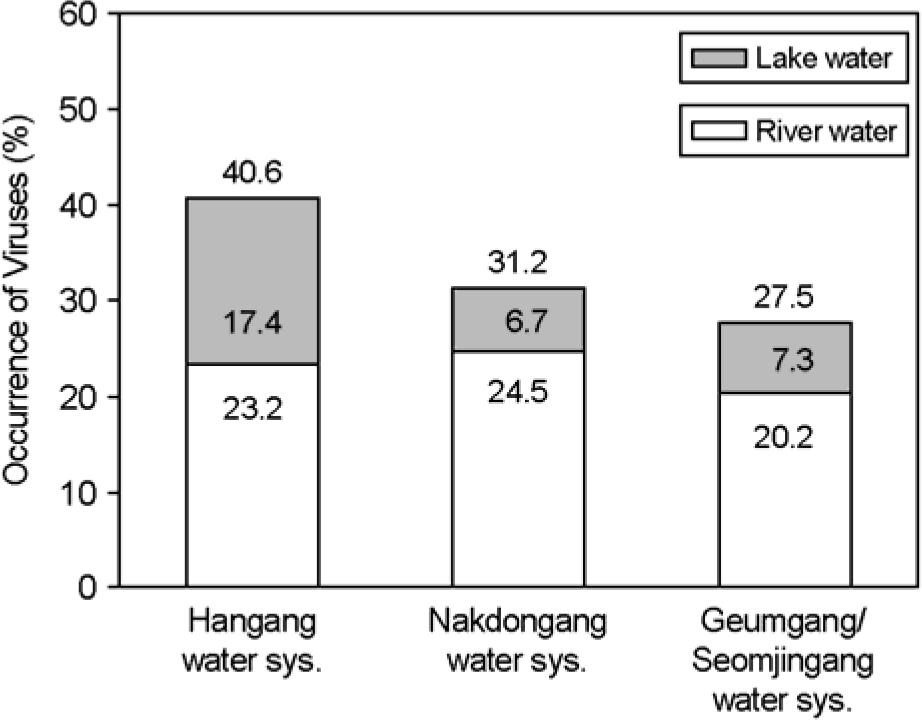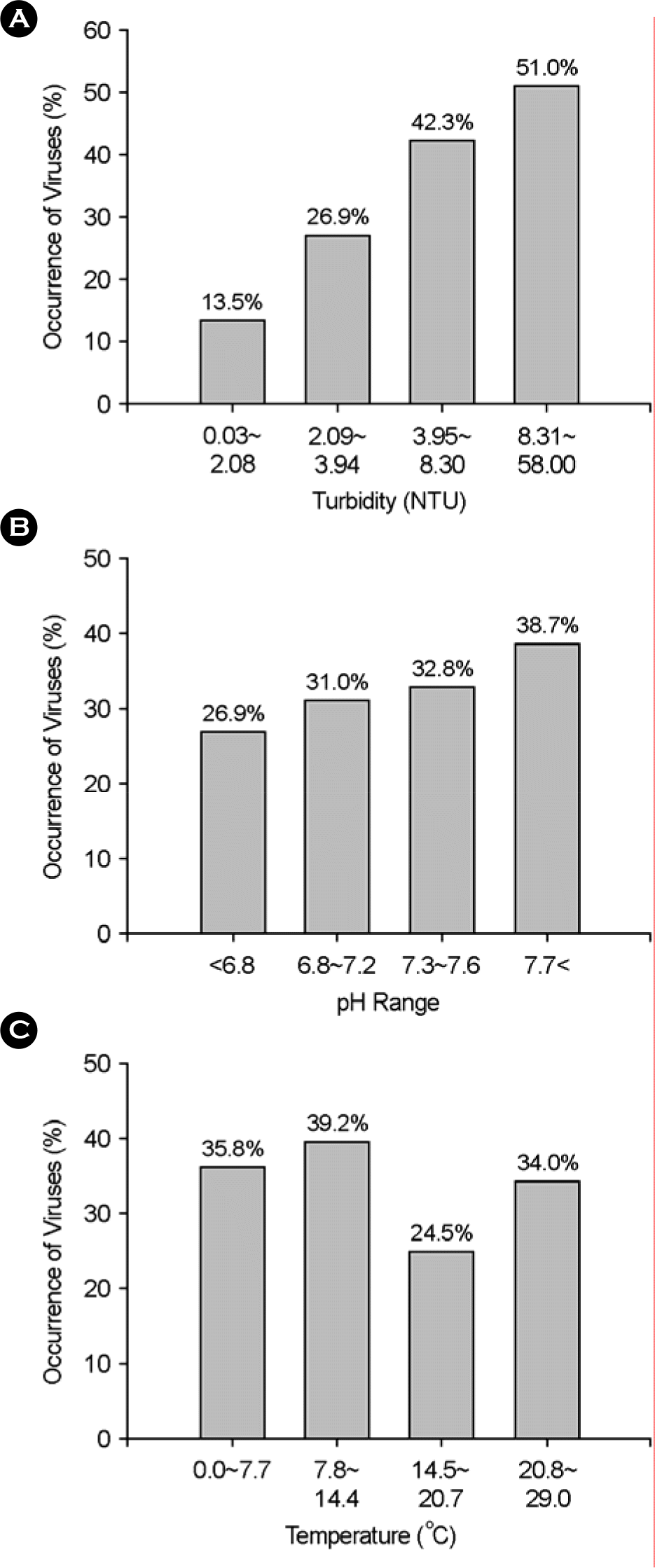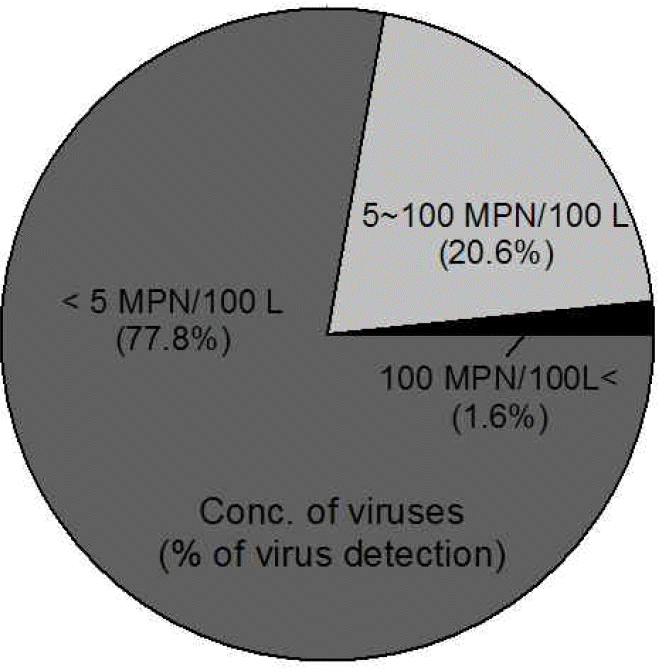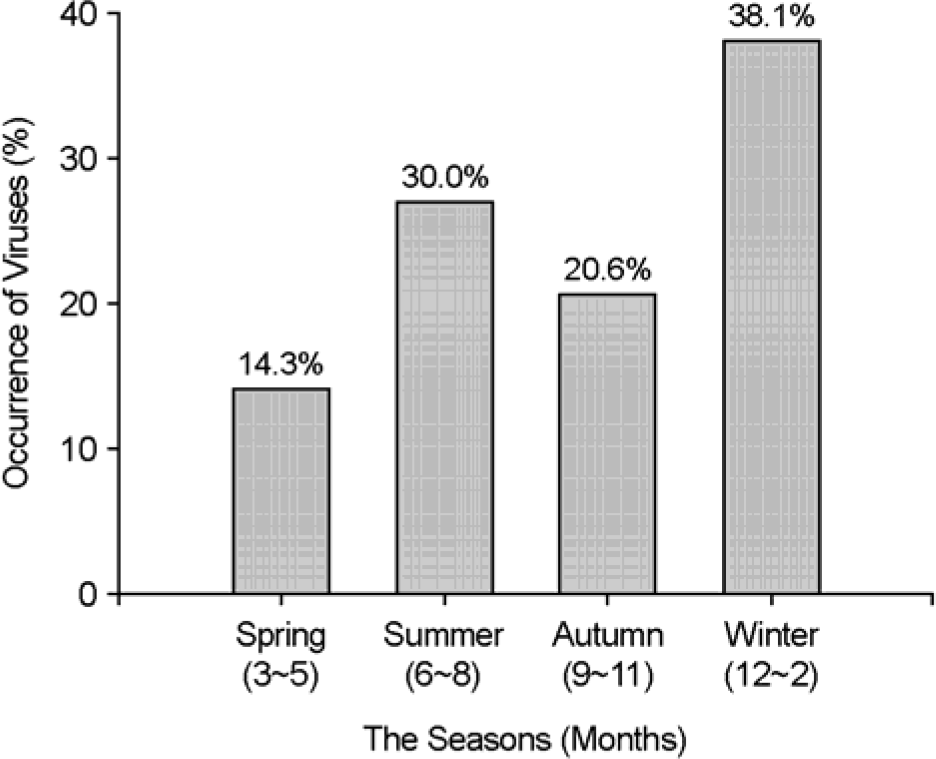Abstract
In order to survey the occurrence of waterborne viruses in Korean surface water, a total of 192 water samples from July 2003 to January 2006 were collected and analyzed. The presence of waterborne viruses was investigated by total culturable virus assay (TCVA) using buffalo green monkey kidney (BGMK) cells. The results showed that 63 of 192 samples (32.8%) were positive for waterborne viruses with the average concentration of 3.1±18 most probable numbers (MPN)/100 L. The relationship between the occurrence of the viruses and the physicochemical environmental factors revealed that there was a significant correlation between the turbidity of water and the occurrence of the viruses. It was also noted that the water temperature might have some relationship with the occurrence of the viruses, as the frequency of the viruses was higher in low temperature or winter season. Therefore, the occurrence of waterborne viruses in Korean surface water might be affected by the physicochemical environmental factors such as turbidity and water temperature.
References
1). 박홍기, 정은영, 이유정, 정종문, 최동훈, 손희종, 권기 원, 홍용기. 부산시 상수원수와 수돗물에서의 수인성 장관계 바이러스 분포조사. 생명과학회지. 13:197–205. 2003.
2). 이보영, 황만식, 문지영, 정 용, 신영오, 이옥재. 서울 시 수돗물과 상수원수에서의 장바이러스 검출과 탁도 발생과의 관계. 대한상하수도학회 · 한국물환경학회 공동 추계학술발표논문집 A-. 14:69–72. 2000.
3). 정은영, 정종문, 류재익, 신판세, 전홍기, 장경립. 지표 수로부터 세포배양-연계 PCR법에 의한 장바이러스의 검출. 생명과학회지. 10:484489. 2000.
4). 환경부. 정수처리에 관한 기준. 환경부고시 제2002–106 호. 2002.
5). Abbaszadegan M, Huber MS, Gerba CP, Pepper IL. Detection of enteroviruses in groundwater with the polymerase chain reaction. Appl Environ Microbiol. 59:1318–1324. 1993.

6). Beller M, Ellis A, Lee SH, Drebot MA, Jenkerson SA, Funk E, Sobsey MD, Simmons III OD, Monroe SS, Ando T, Noel J, Petric M, Middaugh JP, Spika JS. Outbreak of viral gastroenteritis due to a contaminated well: international consequences. JAMA. 278:563–568. 1997.

7). Cho HB, Lee SH, Cho JC, Kim SJ. Detection of adeno-viruses and enteroviruses in tap water and river water by reverse transcription multiplex PCR. Can J Microbiol. 46:417–424. 2000.

9). Dubois E, Merle G, Roquier C, Trompette AL, Le Guyader F, Cruciere C, Chomel JJ. Diversity of enterovirus sequences detected in oysters by RT-heminested PCR. Int J Food Microbiol. 92:35–43. 2004.

10). Farthing MJG. Viruses and the gut. Smith Kline & French, Walwyn Garden City, Hertfordshire, United Kingdom. 1989.
11). Fong TT, Griffin DW, Lipp EK. Molecular assays for targeting human and bovine enteric viruses in coastal waters and application for library-independent source tracking. Appl Environ Micrbiol. 71:2070–2078. 2005.
12). Fong TT, Lipp EK. Enteric viruses of humans and animals in aquatic environments: health risks, detection, and potential water quality assessment tools. Microbiol Mol Biol Rev. 69:357–371. 2005.

13). Fout GS, Martinson BC, Moyer MW, Dahling DR. A multiplex reverse transcription-PCR method for detection of human enteric viruses in groundwater. Appl Environ Microbiol. 69:3158–3164. 2003.

14). Fout GS, Schaefer III FW, Messer JW, Dahling DR, Stetler RE. ICR microbial laboratory manual, Publication no. EPA/600/R-95/178. U.S. Environmental Protection Agency;Washington, D.C., U.S.A.: online:. www.epa.gov/microbes. 1996.
15). Gerba CP, Bitton G. Microbial pollutants: their survival and transport pattern to groundwater. p. p. 78. In. Groundwater Pollution Microbiology. J. Wiley & Sons;New York: 1984.
16). Green DH, Lewis GD. Comparative detection of enteric viruses in wastewaters, sediments and oysters by revers transcription PCR and cell culture. Water Res. 33:1195–1200. 1999.
17). Haas CN, Rose JB, Gerba CP, Regli R. Risk assessment of viruses in drinking water. Risk Anal. 13:545–552. 1993.
18). Harris JR, Cohen ML, Lippy EC. Water-related disease outbreaks in the United States. J Infect Dis. 148:759–762. 1983.
19). Keswick BH, Gerba CP, DuPont HL, Rose JB. Detection of enteric viruses in treated drinking water. Appl Environ Microbiol. 47:1290–1294. 1984.

20). Kocwa-Haluch R. Waterborne enteroviruses as a harzard for human health. Polish J Environ Studies. 10:485–487. 2001.
21). Lawson HW, Braun MM, Glass RI, Stine SE, Monroe SS, Atrash HK, Lee LE, Englender SJ. Waterborne outbreak of Norwalk virus gastroenteritis at a southwest US resort: role of geological formations in contamination of well water. Lancet. 337:1200–1204. 1991.
22). Le Guyader F, Dubois E, Menard D, Pommepuy M. Detection of hepatitis A virus, rotavirus and enterovirus in naturally contaminated shellfish and sediment by reverse transcription seminested PCR. Appl Environ Microbiol. 60:3665–3671. 1994.
23). Lipp EK, Jarrell JL, Griffin DW, Lukasik J, Jacukiewicz J, Rose JB. Preliminary evidence for human fecal contamination in ocrals of the Florida Keys, USA. Mar Poll Bull. 44:666–670. 2002.
24). Lipp EK, Kurz R, Vincent R, Rodriguez-Palacios C, Farrah SR, Rose JB. The effects of seasonal variability and weather on microbial fecal pollution and enteric pathogens in a subtropical estuary. Estuaries. 24:266–276. 2001.

25). Muscillo M, Carducci A, La Rosa G, Cantiani L, Marianelli C. Enteric virus detection in Adriatic seawater by cell culture, polymerase chain reaction, and polyacrylamide gel electro-phoresis. Water Res. 31:1980–1984. 1997.

26). Norder H, Bjerregaard L, Magnius L, Lina B, Aymard M, Chomel JJ. Sequencing of ‘untypable’ enteroviruses reveals two new types, EV-77 and EV-78, within human enterovirus type B and substitutions in the BC loop of the VP1 protein for known types. J Gen Virol. 84:827–836. 2003.

27). Oberste M, Schnurr D, Maher K, al-Busaidy S, Pallansch M. Molecular identification of new picornaviruses and characterization of a proposed enterovirus 73 serotype. J Gen Virol. 82:409–416. 2001.

28). Papaventsis D, Siafakas N, Markoulatos P, Papageorgiou GT, Kourtis C, Chatzichristou E, Economou C, Levidiotou S. Membrane adsorption with direct cell culture combined with reverse transcription-PCR as a fast method for identifying enteroviruses from sewage. Appl Environ Microbiol. 71:72–79. 2005.

29). Stetler RE, Ward RL, Waltrip SC. Enteric virus and indicator bacteria levels in a water treatment system modified to reduce trihalomethane production. Appl Environ Microbiol. 47:319–324. 1984.

30). Tani N, Dohi Y, Jurumatani N, Yonemasu K. Seasonal distribution of adenoviruses, enteroviruses and reoviruses in urban river water. Microbiol Immunol. 39:577–580. 1995.

31). Tani N, Shimamoto K, Ichimura K, Nishii Y, Tomita S, Oda Y. Enteric virus levels in river water. Water Res. 26:45–48. 1992.

Figure 2.
The distribution of waterborne viruses in various water systems in Korea and the difference of occurrence of the viruses between lake and river water.

Figure 3.
Relationship between the occurrence of waterborne viruses and physicochemical environmental factors; turbidity (A), pH (B), and temperature (C).

Table 1.
Sampling sites and the frequency of waterborne viruses




 PDF
PDF ePub
ePub Citation
Citation Print
Print




 XML Download
XML Download